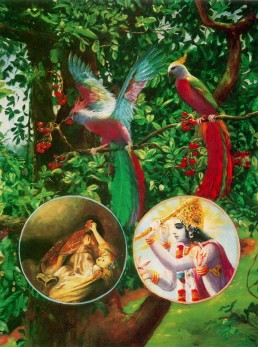Swami Chinmayananda
Swami Chinmayananda Commentary
OF THE NAGAS I AM ANANTA — “Nagas” means “the many-hooded serpents.” Of them, the thousand-hooded Sesha Naga is the one that has been described as forming the “bed” for Lord Vishnu to recline in His “Yoga-sleep.” Here Krishna only means that, among the many-hooded serpents, He is the mightiest and the most divine, because He is the very Substratum upon which Vishnu, the Sustainer, and Brahmaji, the Creator of the multiple world, recline and function.
OF THE WATER DEITIES I AM VARUNA — ‘ Varuna’ is a Vedic conception of the Spirit governing the waters, the third of the five great elements. Deifying the elemental forces in the phenomenal world, was the method of adoration and worship in the early Vedic period. It was only later, that we started the Pauranic-tradition of humanising gods and got into the muddy pool religious differences, sectarian prejudices, and credal warfare, between colonies of ignorant folks, gathered round a Jerusalem Master or a Vrindavana Boy, or a Mecca Messenger. Varuna is conceived of as a being, half-fish and half-man, almost something like Arnold’s Merman! He is the Ruler of the Oceans and the Lord of the Waters.
OF THE PITRIS, I AM ARYAMA — In Hinduism, death is one of the experiences in life when the subtle-body chooses to leave permanently its present residence within a given physical structure. The mind-intellect-equipment, maintaining a separate ego-centric concept in itself, continues its existence and it is commonly called ‘departed soul’ or ‘ancestor.’
These ‘departed souls’ live together in a world of their own, called the “world-of-the manes” (Pitriloka). We have already discussed the Vedic concept of the six children of the twelve Adityas, each presiding over a month of the year. Of these, Aryama is the ruler of the world-of-the-ancestors.
OF THE CONTROLLERS, I AM YAMA — “Yama” is the mythical Lord-of-Death, the Chief Messenger of the Annihilator. In India, we worship the terrible, the sad, and the tragic also, because, to us God is the Substratum for both the good and the bad, for the pleasant and the unpleasant. We are not satisfied by any theory of compromise by which we reject, in God, any association with what we do not like.
Whether we like it or not, the Principle-of-Death is the governing factor that controls and regulates life, and, at every moment, prepares a progressive field for creative developments everywhere. The childhood must die before youth can express itself. I must leave my high school in order to enter the college. Step by step, I must die in order to be born into the next step. Progress in itself is a partial picture of life; it is only a squint-eyed vision of life’s total dynamism. Every development is preceded by prior destruction. Annihilation, thus contributing to positive progress, is called “Death’s own creative art.”No new thing can be created unless correspondingly we also destroy that which existed before. We arrive at this assertive but logical conclusion when we sufficiently digest the observed physical law of the world that “no two things can ever remain at one and the same period of time occupying one and the same space.” When a painter paints a flower, he not only pours his colour on to the canvas to paint his subject, but his creative art is a constant destruction of the surface coating that was earlier given to the canvas!
Thus, when life is viewed in its totality, there is as much importance for the “Principle-of-Death” as for the very “Principle-of-Creation.”
But for Death functioning intelligently at almost the same speed as the rate of Creation, there would have been an inordinate flood of things in life; and life itself would have been choked by its own magnitude and number. If Death were not there, the great-great-great-grandfather of our great-great-great-grandfather might still be living, even now, in our own present two-roomed apartment! Even when there is a slight rise in population, the entire balance and political peace in the world get shattered. What will not happen, if Death were not as sincerely serving us as the Creator? Indeed, of all the Controllers, Death alone is the Chief and the analogy given here is irreplaceable and supremely apt.
IN A SPELL OF PLEASANT ENTHUSIASM THE LORD CONTINUES:
Adi Sankara Commentary
Naganam, among snakes, of a particular species of snakes; asmi, I am Ananta, the King of snakes. And Varuna, the King yadasam, of the gods of the waters. Pitrnam, among the manes; I am the King of the manes, named Aryama. And samyamatam, among the maintainers of law and order I am Yama.
The Bhagavad Gita with the commentary of Sri Sankaracharya – Translated by Alladi Mahadeva Sastry
Holy Geeta – Commentary by Swami Chinmayananda
The Bhagavad Gita by Eknath Easwaran – Best selling translation of the Bhagavad Gita
The Bhagavad Gita – Translation and Commentary by Swami Sivananda
Bhagavad Gita – Translation and Commentary by Bhaktivedanta Swami Prabupadha
Srimad Bhagavad Gita Chapter 10 – Verse 29 – 10.29 anantascasmi naganam – All Bhagavad Gita (Geeta) Verses in Sanskrit, English, Transliteration, Word Meaning, Translation, Audio, Shankara Bhashya, Adi Sankaracharya Commentary and Links to Videos by Swami Chinmayananda and others – 10-29

